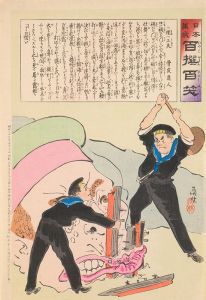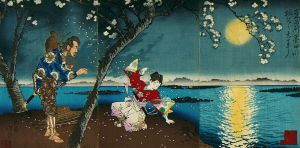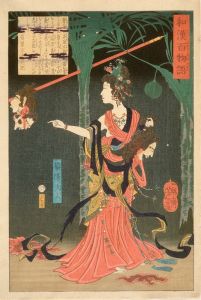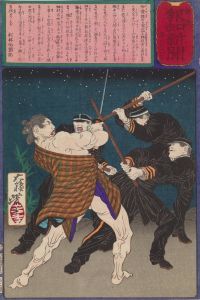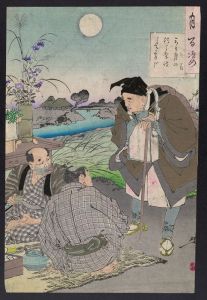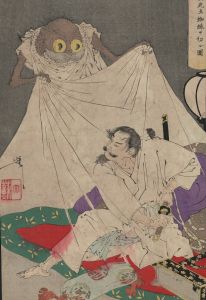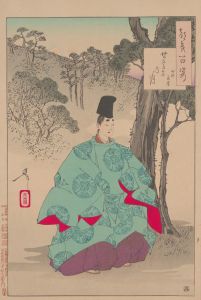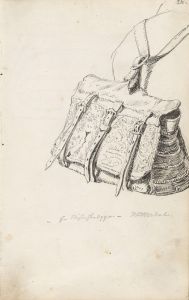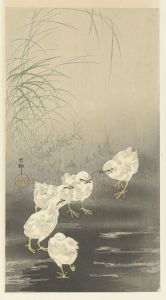
Ishiyama moon
A hand-painted replica of Tsukioka Yoshitoshi’s masterpiece Ishiyama moon, meticulously crafted by professional artists to capture the true essence of the original. Each piece is created with museum-quality canvas and rare mineral pigments, carefully painted by experienced artists with delicate brushstrokes and rich, layered colors to perfectly recreate the texture of the original artwork. Unlike machine-printed reproductions, this hand-painted version brings the painting to life, infused with the artist’s emotions and skill in every stroke. Whether for personal collection or home decoration, it instantly elevates the artistic atmosphere of any space.
Tsukioka Yoshitoshi was a prominent Japanese artist known for his work in the ukiyo-e genre, a style of woodblock prints and paintings that flourished in Japan from the 17th through 19th centuries. One of his notable series is "One Hundred Aspects of the Moon" (Tsuki hyakushi), which was created between 1885 and 1892. This series consists of 100 woodblock prints, each depicting a scene inspired by Japanese and Chinese legends, historical events, and classical literature, all unified by the theme of the moon.
"Ishiyama Moon" is one of the prints from this series. The print illustrates a scene associated with the famous Japanese poet and court lady Murasaki Shikibu, who is best known for writing "The Tale of Genji," often considered the world's first novel. The scene is set at Ishiyama-dera, a temple located near Lake Biwa in Japan, where Murasaki is said to have begun writing her monumental work. The temple is renowned for its scenic beauty and historical significance, and it is traditionally believed that Murasaki found inspiration for her writing while gazing at the moon from this location.
In "Ishiyama Moon," Yoshitoshi captures the serene and contemplative atmosphere of the temple at night. The composition typically features Murasaki Shikibu seated in a room, with the moonlight streaming in, casting gentle shadows and illuminating her figure. The moon itself is often depicted as a luminous presence in the sky, symbolizing inspiration and the passage of time. Yoshitoshi's use of delicate lines and subtle color gradations enhances the ethereal quality of the scene, inviting viewers to reflect on the interplay between nature, creativity, and the human experience.
Yoshitoshi's "One Hundred Aspects of the Moon" series, including "Ishiyama Moon," is celebrated for its artistic innovation and emotional depth. The series was created during a period of significant change in Japan, as the country was transitioning from the Edo period to the Meiji era, a time marked by rapid modernization and Western influence. Despite these changes, Yoshitoshi's work remained deeply rooted in traditional Japanese culture and aesthetics, offering a poignant commentary on the enduring power of classical themes and the natural world.
"Ishiyama Moon" exemplifies Yoshitoshi's mastery of the ukiyo-e technique, showcasing his ability to blend traditional subject matter with a modern sensibility. His prints are characterized by their dynamic compositions, expressive figures, and intricate details, which together create a vivid and immersive visual experience. Today, Yoshitoshi is regarded as one of the last great masters of ukiyo-e, and his work continues to be highly regarded for its artistic and cultural significance.
The "One Hundred Aspects of the Moon" series, including "Ishiyama Moon," remains a valuable part of art collections worldwide, appreciated for its historical context and Yoshitoshi's unique vision. Through these prints, Yoshitoshi not only preserved the rich tapestry of Japanese folklore and history but also captured the universal themes of beauty, inspiration, and the passage of time, resonating with audiences across generations.





